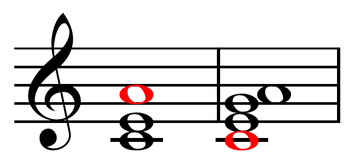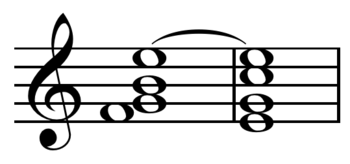- Sixth chord
-
 'Sixth' chords over C bass:
'Sixth' chords over C bass:
 Play first inversion A minor chord (help·info) or
Play first inversion A minor chord (help·info) or  Play C major Add6 chord (help·info). Chord roots in red.
Play C major Add6 chord (help·info). Chord roots in red.A sixth chord may be any of several kinds of chord depending on the use of the term in classical music and popular music.[1][2] The original meaning of the term is a chord in first inversion, in other words with its third in the bass and its root a sixth above it. This is how the term is still used in classical music today, and in this sense it is also called a chord of the sixth.[3]
In modern popular music, a sixth chord is any triad with an added sixth above the root as a chord factor.[4] This was traditionally (and in classical music is still today) called an added sixth chord or triad with added sixth[5] since Jean-Philippe Rameau (sixte ajoutée) in the 18th century. It is not common to designate chord inversions in popular music, so there is no need for a term designating the first inversion of a chord, and so the term sixth chord can be used in popular music as a short way of saying added sixth chord. When not otherwise specified, it usually means a major triad with an added major sixth interval (a major sixth chord). However, a minor triad is also used, together with the same interval, resulting in a minor sixth chord (also known as minor major sixth).
Contents
History
In early music, what is today called a sixth chord or first inversion in classical music was considered an autonomous harmonic entity with the root named by the bass, while it was later simply considered an inversion of a chord with the bass being the third (not the root) and the root being the sixth (not the bass). In jazz, this form is referred to as a major sixth chord.
Alternatively, rather than as a six three chord, the note a may be analyzed as a suspension or appoggiatura, "first resolved and later...retained as a part of the chord, no resolution taking place.":[6]
The dominant chord's fifth may be substituted by the chord's sixth, analyzed as its thirteenth:[7]
In popular music
 C Major chord with added sixth
C Major chord with added sixth
What in popular music is called a sixth chord was traditionally called an "added sixth chord". As the name suggests, this is a triad with an added sixth interval. It is generally built on the sub-dominant note (fourth scale degree), although it can be built on any note. Typically, the triad is a major triad and the additional sixth interval is major (major sixth chord). For example, a major sixth chord built on C (denoted by C6, or CM6) consists of the notes C, E, G, and the added major sixth A
 Play (help·info). These are the same notes as those of an A minor seventh chord - whether such a chord should be regarded as an added sixth chord or a seventh depends on its context and harmonic function. To explain the analyses as added sixth chords, against common practice period theory,[8] provides the example of the final tonic chord of some popular music being traditionally analyzable as a "submediant six-five chord" (added sixth chords by popular terminology), or a first inversion seventh chord (possibly the dominant of the mediant V/iii). According to the interval strengths of the added sixth chord the root of the strongest interval of the chord in first inversion (CEGA), the perfect fifth (C-G), is the bottom (C), the tonic.
Play (help·info). These are the same notes as those of an A minor seventh chord - whether such a chord should be regarded as an added sixth chord or a seventh depends on its context and harmonic function. To explain the analyses as added sixth chords, against common practice period theory,[8] provides the example of the final tonic chord of some popular music being traditionally analyzable as a "submediant six-five chord" (added sixth chords by popular terminology), or a first inversion seventh chord (possibly the dominant of the mediant V/iii). According to the interval strengths of the added sixth chord the root of the strongest interval of the chord in first inversion (CEGA), the perfect fifth (C-G), is the bottom (C), the tonic. C minor chord with added major sixth
C minor chord with added major sixth
In jazz, the minor sixth chord (sometimes: minor major sixth, or minor/major sixth)
 Play (help·info) is frequently used. It is unlike the major sixth chord, which is often substituted for a major triad; the minor sixth plays a number of different harmonic roles. The chord consists of a minor triad with a tone added a major sixth above the root; thus in C, it would contain the notes C, E♭, G, and A. This chord might be notated Cm6, Cm/M6, Cmin/maj6, Cmin(maj6), etc. Note that Cm6 has the same notes as F9 with the root omitted, i.e. the notes F (omitted), A, E♭, C, and G. These notes form a tetrad with several enharmonic equivalents: C/E♭/G/A might be written as Cm6, F9, F9 (no root), Am7♭5, B7♭9, or B-alt. Many jazz chord charts use these chord notations indiscriminately, particularly in the choice of minor sixth versus dominant ninth chords. Thus, in some cases when a Cm6 is indicated, the F9 is in fact a better harmonic choice, i.e. closer to the composer's harmonic intent; or vice versa. Analysis of the movement of the root tone, and the present of dominant harmonies, will generally indicate which enharmonic chord is the appropriate notation choice. In some cases, the harmony is ambiguous.
Play (help·info) is frequently used. It is unlike the major sixth chord, which is often substituted for a major triad; the minor sixth plays a number of different harmonic roles. The chord consists of a minor triad with a tone added a major sixth above the root; thus in C, it would contain the notes C, E♭, G, and A. This chord might be notated Cm6, Cm/M6, Cmin/maj6, Cmin(maj6), etc. Note that Cm6 has the same notes as F9 with the root omitted, i.e. the notes F (omitted), A, E♭, C, and G. These notes form a tetrad with several enharmonic equivalents: C/E♭/G/A might be written as Cm6, F9, F9 (no root), Am7♭5, B7♭9, or B-alt. Many jazz chord charts use these chord notations indiscriminately, particularly in the choice of minor sixth versus dominant ninth chords. Thus, in some cases when a Cm6 is indicated, the F9 is in fact a better harmonic choice, i.e. closer to the composer's harmonic intent; or vice versa. Analysis of the movement of the root tone, and the present of dominant harmonies, will generally indicate which enharmonic chord is the appropriate notation choice. In some cases, the harmony is ambiguous.Special kinds of sixth chords
The Neapolitan sixth is the first inversion of a major triad built on the flattened supertonic (second degree of the scale) - a Neapolitan sixth in C major, therefore, consists of the notes F, A♭ and D♭.
 Neapolitan sixth chord preceding authentic cadence (V-I) (help·info)
Neapolitan sixth chord preceding authentic cadence (V-I) (help·info)There are a number of augmented sixth chords. Each of them has a major third and augmented sixth above the bass. When these are the only three notes present, the chord is an Italian sixth
 Italian sixth moving to V. (help·info); when an augmented fourth is added above the bass, the chord is a French sixth
Italian sixth moving to V. (help·info); when an augmented fourth is added above the bass, the chord is a French sixth  French sixth moving to V. (help·info); while adding a perfect fifth above the bass of an Italian sixth makes it a German sixth
French sixth moving to V. (help·info); while adding a perfect fifth above the bass of an Italian sixth makes it a German sixth  German sixth moving to V (help·info) (the etymology of all these names is unclear). All usually have the flattened sub-mediant (sixth degree of the scale, A flat in C major, for example) as the bass note -in this case, they tend to resolve to the dominant.
German sixth moving to V (help·info) (the etymology of all these names is unclear). All usually have the flattened sub-mediant (sixth degree of the scale, A flat in C major, for example) as the bass note -in this case, they tend to resolve to the dominant.Sixth, sixth chord, and added sixth
 Third inversion C added sixth chord. The "sixth" is the bass. Am7 chord.
Third inversion C added sixth chord. The "sixth" is the bass. Am7 chord.
In music, the sixth factor of a chord is the note or pitch six scale degrees above the root or tonal center (see sixth chord). When the sixth is the bass note, or lowest note, of the expressed chord, the chord is in third inversion
 Play (help·info). However, this is equivalent to a seventh chord.
Play (help·info). However, this is equivalent to a seventh chord.Conventionally, the sixth is third in importance to the root, fifth, and third, being an added tone. It is generally not allowed as the root since that inversion resembles a seventh chord on the sixth rather than an added tone on the original note. In jazz chords and theory, the sixth is required due to its being an added tone.
The quality of the sixth may be determined by the scale or may be indicated. For example, in a major scale a diatonic sixth added to the tonic chord will be major (C-E-G-A) while in minor it will be minor (C-E♭-G-A♭).
The sixth is octave equivalent to the thirteenth. If one could cut out the notes in between the fifth and the thirteenth and then drop the thirteenth down an octave to a sixth, one would have an added sixth chord (CEGB♭D'F'A' – B♭D'F' = CEGA).
See also
- 6/9 chord
References
- ^ Music: The Listener's Art, p. 113
- ^ Keith Wyatt and Carl Schroeder (1998). Harmony and Theory: A Comprehensive Source for All Musicians, p. 82. ISBN 0793579910.
- ^ Piston, Walter (1987). Harmony, p. 66. ISBN 0393954803.
- ^ Miller, Michael (2005). The Complete Idiot's Guide to Music Theory, p.119. ISBN 9781592574377.
- ^ Piston, p. 359
- ^ Miller, Horace Alden (1930). New Harmonic Devices, p.51.
- ^ Miller (1930), p.52.
- ^ Cope (1997). Techniques of the Contemporary Composer, p.40-41. New York, New York: Schirmer Books. ISBN 0-02-864737-8.
Chords By type Major · Minor · Dominant · Dominant seventh flat five · Diminished · Half-diminished · Diminished major · Minor-major · Augmented major · Augmented minor · Nondominant · Harmonic seventh chordAdded
/ omittedBy function SecondaryWith names Elektra chord · Farben chord · Hendrix chord · Mu chord · Mystic chord · Northern lights chord · Petrushka chord · Power chord · Psalms chord · So What chord · Spider chord · Tristan chord · Viennese trichord · Dream chordOther Common chord (music) · Mixed interval · Open chord · Polychord · Primary triad · Quartal and quintal · Slash chord · Subsidiary chord · Synthetic chord · Tone clusterCategories:- Chord factors
- Chords
- Chromaticism
Wikimedia Foundation. 2010.





